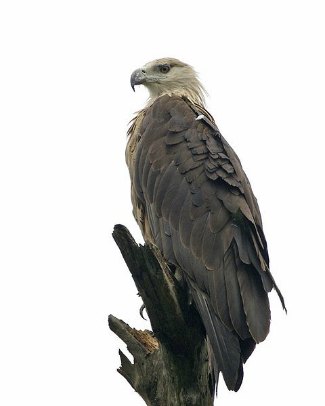Pallas's Fish Eagle - Haliaeetus leucoryphus
By Lip Kee, CC-BY-SA-2.0, via Wikimedia Commons
Family: Accipitridae
Genus: Haliaeetus
Species: H. leucoryphus
Pallas's Fish Eagles are large brown and white raptors that have an extensive range across Central and South Asia. They form a clade with Haliaeetus albicilla (White-Tailed Eagle), H. leucocephalus (Bald Eagle), and H. pelagicus (Steller’s Sea Eagle).
Physical Description:
Pallas's Fish Eagles are dark brown from above with a pale brown-gray head and neck and a brown underside. The long and rounded tail is black with a thick white band. The wings and neck are long, which makes the head appear small compared to their body size. The eyes are brown, the cere and beak are gray, and the feet are a dull white.
Juveniles are brown from above and below with white markings on the underwing.
Their call is a loud, creaky "kha kha kha kha" and they are noisy during the breeding season. Listen to a Pallas's Fish Eagle.
Size:
Length: 76-84 cm
Wingspan: 180-205 cm
Weight: Male: 2.0-3.3 kg. Female: 2.1-3.7 kg.
Habitat and Distribution:
They live near freshwater systems such as lakes, marshes, and large rivers, from 0-5,000 meters above sea level. They also occur in habitats similar to steppes.
Pallas's Fish Eagles are found in Central, East, and South Asia: They occur from Kazakhstan, Turkmenistan, Uzbekistan, and Mongolia to northern and south-central China, in addition to the northern Indian subcontinent in Pakistan, northern India, Bhutan, Bangladesh, and Myanmar. They are migratory, with northern birds leaving for Iran and Afghanistan. In Kazakhstan, migration begins in September-October and they return to breed in March-April. In India they move from hotter lowlands to higher altitudes after breeding in May-June. Their total range spans 5,270,000 km² from 52°N to 16°N, and there are an estimated 2,500-9,999 individuals thinly distributed throughout.
By Pete Favelle, CC-BY-NC-2.0, via Flickr
Diet and Hunting:
As indicated by their name, the diet of Pallas's Fish Eagles is mostly fish, which they catch close to surface of the water. They also eat birds and nestlings, mammals, reptiles, and carrion.
They are known to hunt in pairs. Sometimes they steal food from other birds—behavior known as kleptoparasitism—including Pandion haliaetus (Osprey), Circus aeruginosus (Western Marsh Harrier), and Haliastur indus (Brahminy Kite). Pallas's Fish Eagles have also been observed sitting on their prey in water, in an apparent attempt to drown them.
Reproduction:
Pairs are monogamous. The breeding season is October-June in the southern part of their range, March-July in the north, and May-September in Tibet.
The nest is built out of sticks by both parents and placed in a tall tree close to water. It is lined with green leaves, hay, rushes, straw, and fine twigs. Nests are sometimes used for years in a row and can be up to 2 m across and 2 m deep. Clutch size is 2-4 eggs, which are incubated for 40-45 days, also by both parents though the female does the majority. The chicks hatch two days apart and the younger always dies due to its inability to compete with the older sibling. Fledging takes 70-105 days and juveniles are dependent on their parents for around 30 days after that.
By Lip Kee, CC-BY-SA-2.0, via Wikimedia Commons
Conservation:
The population is declining due to shooting, disturbance, reduced prey, habitat loss in the form of drained wetlands and the felling of large trees required for nesting, and environmental contaminants such as DDE (a breakdown product of the pesticide DDT). They have been listed as Vulnerable by BirdLife International.
Conservation measures proposed including surveys to better determine the status, distribution, and threats to Pallas's Fish Eagles, protecting areas with important populations, management of wetlands, limiting the use of pesticides and industrial discharge close to wetlands, controlling water hyacinths whose growth prevents the eagles from hunting, protecting trees and reintroducing suitable ones around wetlands, protecting nest sites, and promoting rural education programs.
Taxonomy:
Species Haliaeetus albicilla (White-Tailed Eagle), H. leucocephalus (Bald Eagle), and H. pelagicus (Steller’s Sea Eagle) form a clade with H. leucoryphus.
Molecular analyses have shown that the genus Haliaeetus is closely related to the kite genera Milvus and Haliastur.
Other Names:
Band-Tailed Fishing Eagle, Long-Tailed Eagle, Pallas' Fish Eagle, Pallas's Fishing Eagle, Pallas's Eagle, Pallas's Sea Eagle, Ring-Tailed Fishing Eagle, Orel páskovaný (Czech), Pallas Havørn (Danish), Witbandzeearend (Dutch), Vöötsaba-merikotkas (Estonian), Aromerikotka (Finnish), Pygargue de Pallas, (French), Bindenseeadler (German), Gjálpörn (Icelandic), Aquila di mare di Pallas (Italian), Kigashiraumiwashi (Japanese), Båndhavørn (Norwegian), Bielik wschodni (Polish), Pigargo de Pallas (Spanish), Bandhavsörn (Swedish).
Video of a Pallas's Fish Eagle:
References:
http://www.arkive.org/pallass-fish-eagle/haliaeetus-leucoryphus/
http://avibase.bsc-eoc.org/species.jsp?avibaseid=F3CCFC1881D339F6
BirdLife International (2012) Species factsheet: Haliaeetus leucoryphus. Downloaded from http://www.birdlife.org on
03/02/2012.
http://www.birds.kz/Haliaeetus%20leucoryphus/indexe.html
Global Raptor Information Network. 2012. Species account: Pallas's Fish Eagle Haliaeetus leucoryphus. Downloaded from
http://www.globalraptors.org on 3 Feb. 2012
http://www.planetofbirds.com/accipitriformes-accipitridae-pallass-sea-eagle-haliaeetus-leucoryphus
Ferguson-Lees, James, and Christie, David A. Raptors of the World. Houghton Mifflin Company, 2001.
http://www.scientificlib.com/en/Biology/Animalia/Chordata/Aves/HaliaeetusLeucoryphus01.html


